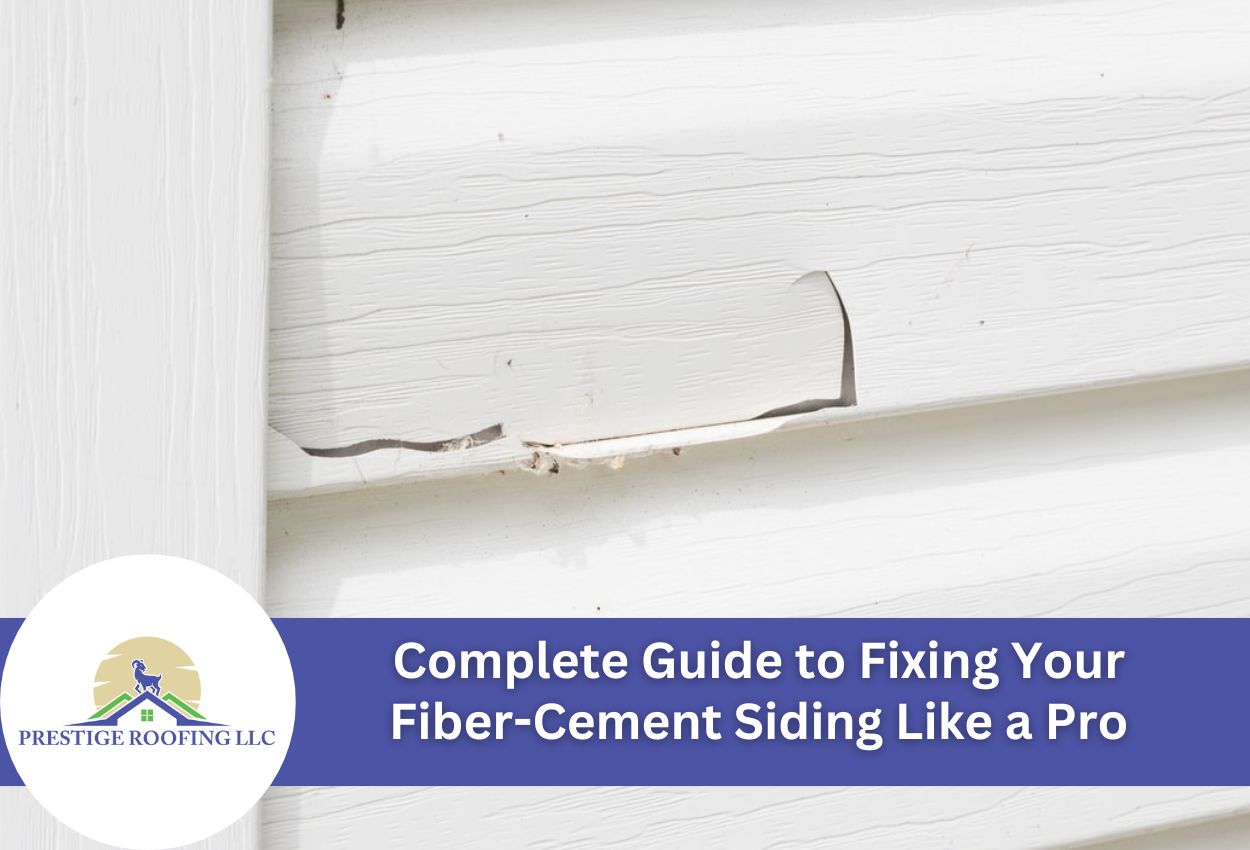Fiber-cement siding has become the go-to choice for homeowners seeking durable, weather-resistant exterior protection. This engineered material combines cement, sand, and cellulose fibers to create boards that withstand harsh weather conditions while maintaining their appearance for decades. Despite its reputation for strength, fiber-cement siding can develop problems over time that require attention.
Common issues include hairline cracks from settling, chips from impact damage, and loose or warped boards from moisture exposure. These problems often start small but can lead to water infiltration and structural damage if left unaddressed. Understanding when fiber-cement siding maintenance falls within DIY capabilities versus requiring professional intervention saves both time and money.
Simple siding crack repair and touch-up work typically fall within the scope of weekend projects. However, extensively damaged siding or issues involving multiple boards often benefit from professional expertise. The key lies in accurately assessing the extent of damage and understanding the techniques required for exterior siding restoration.
Proper fiber-cement board installation and repair techniques ensure long-lasting results that protect your home while maintaining its curb appeal. Addressing repairs promptly prevents small issues from needing complete replacement.
Spotting the Warning Signs Your Siding Needs Attention
Regular inspection of fiber-cement siding helps catch problems before they need expensive repairs. Visual damage often appears as hairline cracks running vertically or horizontally across boards, particularly near corners and joints where settling stress concentrates. Chips typically occur along board edges from impact damage or freeze-thaw cycles, while loose boards may bow outward or create gaps between sections.
During routine home inspections, examine boards for color changes that indicate moisture has gotten beneath the surface. Dark staining or discoloration often signals water infiltration that can compromise the material’s integrity. Check caulk lines around windows, doors, and trim for separation or cracking that allows moisture behind the siding.
More serious warning signs include soft or spongy areas when pressed, which suggest underlying structural damage. Black or green spots indicate mold growth, typically resulting from prolonged moisture exposure. Warped or cupped boards signal significant water damage that may extend to sheathing and framing materials.
Pay attention to interior signs like water stains on walls or peeling paint near siding connections. These symptoms often indicate that damaged siding replacement is necessary rather than simple fiber-cement siding maintenance. Bulging walls or visible daylight through gaps require immediate professional evaluation to prevent further structural compromise.
Tools and Materials Needed for Fiber-Cement Siding Repairs
Fiber-cement siding repair requires specific tools designed to handle this dense, abrasive material safely. Essential hand tools include a circular saw with carbide-tipped blades specifically designed for cement products, as standard wood blades dull quickly and create rough cuts. A quality caulk gun, putty knives of various sizes, and fine-grit sandpaper help achieve professional-looking results during siding crack repair projects.
Safety equipment is critical when working with fiber cement. Dust masks protect against silica particles released during cutting and sanding. Safety glasses, work gloves, and long sleeves prevent irritation from cement dust. A shop vacuum with HEPA filtration helps contain dust during siding replacement work.
Specialized items for different repair types include elastomeric caulk for filling cracks and fiber cement shears for precise cutting without power tools. Pry bars and nail sets help remove damaged sections without affecting adjacent boards during exterior siding restoration projects.
Selecting compatible materials ensures lasting repairs that match existing siding systems. Replacement boards must match the original thickness, texture, and profile exactly. High-quality caulks provide flexible seals that move with temperature changes. Primers specifically formulated for fiber-cement products create proper adhesion, while 100% acrylic exterior paints offer superior durability and color retention for fiber-cement siding maintenance projects.
Step-by-Step Repair Techniques for Common Problems
Addressing minor damage through targeted fiber-cement siding maintenance prevents small issues from getting significantly worse. Small cracks and holes respond well to specialized patching compounds designed specifically for cement-based materials. Begin by cleaning the damaged area thoroughly, removing loose material and debris that could interfere with proper adhesion.
For hairline cracks, apply exterior-grade caulk using steady pressure to ensure complete coverage. Work the material into the crack using a putty knife, smoothing excess caulk to match the surrounding surface texture. Larger holes require a specific fiber cement patching compound mixed according to the manufacturer’s instructions. Apply the compound in thin layers, allowing each coat to cure completely before adding additional material.
When cracks extend beyond surface-level damage, the affected board may need to be removed and replaced. Start by carefully scoring the caulk lines around the damaged section using a utility knife. Remove fasteners using appropriate tools, taking care not to damage adjacent boards during extraction. Install replacement boards following original installation patterns, ensuring proper overlap and fastener placement.
Damaged siding replacement projects require attention to weatherproofing details that protect the underlying structure. Apply house wrap or building paper behind replacement sections, sealing all joints with appropriate tape. Install new boards with corrosion-resistant fasteners, maintaining consistent spacing and penetration depth. Complete the exterior siding restoration by applying primer and paint that matches existing finishes.
When Professional Intervention is Necessary
Extensive damage across multiple fiber-cement boards signals the need for professional exterior siding restoration rather than spot repairs. Large sections showing simultaneous cracking, warping, or delamination typically indicate underlying structural issues that basic repairs cannot address. When damage covers more than 30% of a wall section or involves multiple adjacent boards, the scope exceeds typical DIY maintenance capabilities.
Structural concerns requiring a professional assessment include foundation settling that creates recurring cracks, improper initial installation causing widespread board failure, or moisture infiltration affecting multiple parts of the building. These conditions mean a comprehensive evaluation of framing, sheathing, and vapor barriers is necessary before any siding work begins.
Professional contractors possess specialized equipment for large-scale fiber-cement board installation projects, including pneumatic shears, dust collection systems, and scaffolding for safe access to upper elevations. They understand building codes specific to siding installations and can identify problems that homeowners might overlook, such as inadequate flashing details or ventilation issues contributing to ongoing moisture problems.
The complexity of matching existing siding profiles, textures, and colors across extensive areas often requires professional expertise to achieve seamless results. When multiple building systems require coordination during repair work, professional contractors ensure proper sequencing and integration to prevent future problems while maintaining structural integrity and weather protection throughout the restoration process.
Keeping Your Siding in Top Shape After Repairs
Maintaining fiber-cement siding after repairs requires consistent attention to prevent recurring problems and extend the lifespan of both new and existing materials. A routine approach to fiber-cement siding maintenance protects the investment made in initial repairs while preserving the home’s exterior appearance.
Monthly visual inspections should focus on areas where previous siding crack repair work occurred, checking for signs of new damage or failure in repair materials. Look for separation in caulk lines, changes in paint finish, or any movement in repaired boards that might indicate settling or moisture issues. Pay particular attention to joints between new and existing materials where different expansion rates can create stress points.
Annual deep cleaning removes accumulated dirt, mildew, and organic debris that can trap moisture against the siding surface. Use a soft-bristled brush with a mild detergent solution, working from bottom to top to prevent streaking. Never use pressure washers, which can force water behind boards or damage surface textures. After cleaning, inspect all fasteners, trim connections, and flashing details for signs of corrosion or loosening that could compromise weather protection.
Regular sealing and painting preserve the integrity of fiber-cement board installation work and prevent moisture infiltration. Touch up paint chips or scratches promptly using high-quality primers and paints specifically formulated for fiber-cement products. Apply caulk to maintain weatherproof seals around windows, doors, and trim connections, replacing deteriorated materials before they allow water infiltration that leads to more extensive exterior siding restoration needs.
Making Smart Decisions About Professional Help
Certain fiber-cement siding repairs exceed DIY capabilities and require specialized contractor expertise. Complex projects involving structural modifications, extensive damage across multiple walls, or repairs requiring specialized equipment should be handled by experienced professionals. Multi-story installations, intricate trim work, and projects involving electrical or plumbing typically require professional skills and liability coverage.
Structural damage indicators include sagging walls, multiple cracked boards in concentrated areas, or water damage extending behind the siding to framing members. These conditions require a comprehensive assessment of building systems that amateur repairs cannot adequately address. Professional contractors possess the expertise to identify underlying causes and implement solutions that prevent recurring problems.
When consulting local siding professionals, ask specific questions about their experience with fiber-cement siding and certification with major manufacturers. Request detailed written estimates outlining material specifications, labor procedures, and project timelines for exterior siding work. Verify licensing, insurance coverage, and recent references from similar repair projects in your area.
Professional repair processes typically begin with a thorough damage assessment and moisture testing to determine the full scope of work needed. Contractors should explain their approach to matching existing materials, describe weatherproofing procedures, and provide warranties covering both materials and workmanship. Experienced professionals coordinate permits when required and ensure all repair work meets local building codes while maintaining your home’s structural integrity and weather protection throughout the restoration process.
Green Bay’s Premier Fiber-Cement Siding Contractor: Prestige Roofing LLC
If your home’s fiber-cement siding has suffered from wear and tear, it’s crucial to address any issues as soon as possible to maintain its durability and curb appeal. Recognizing when DIY fixes are insufficient and professional intervention is needed can save you both time and money. For complex or extensive damage, Prestige Roofing LLC is your go-to expert in Green Bay. Our skilled team is equipped to handle all types of fiber-cement siding repair, from minor crack repairs to complete siding restoration.
Don’t let damaged siding compromise your home’s safety and appearance. Call Prestige Roofing LLC today at (920) 791-0414 to keep your fiber-cement siding in top condition. Our professional advice and superior service can help preserve the integrity and beauty of your home.

